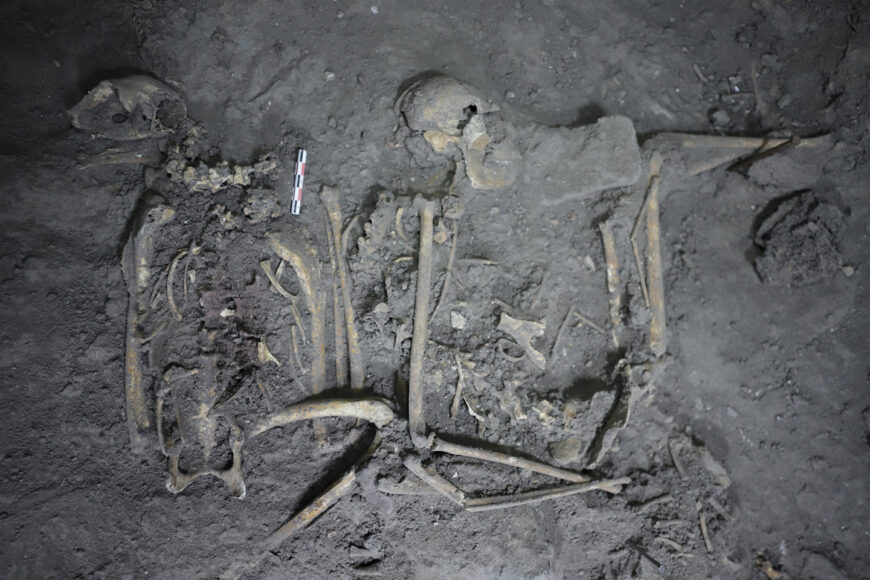The Remains Of A Spider Monkey Discovered In Teotihuacán, Mexico, Reveal The Story Of Ancient Diplomacy In The Americas
The remains of a spider monkey discovered in Teotihuacán, Mexico, reveal the story of ancient diplomacy in the Americas. The sacrificial spider monkey sheds fresh insight into a long-forgotten Mesoamerican bond. This discovery lets academics put together evidence of high diplomatic connections and debunks earlier ideas that Maya presence in Teotihuacán was limited to migratory populations.
Author:Rhyley CarneyReviewer:Paula M. GrahamNov 25, 20227.8K Shares122.2K Views

The remains of a spider monkey discovered in teotihuacán, mexico, reveal the story of ancient diplomacy in the americas. The sacrificial spider monkey sheds fresh insight into a long-forgotten Mesoamerican bond. This discovery lets academics put together evidence of high diplomatic connections and debunks earlier ideas that Maya presence in Teotihuacán was limited to migratory populations.
The 1,700-year-old monkey suggests the mammal was a Maya diplomatic gift. Researchers claim in the Proceedings of the National Academy of Scienceson November 21 that their discovery is the first evidence of a primate maintained in captivity in the Americas.
The study is largely supported by funding from the National Science Foundation and the National Endowment for the Humanities. Teotihuacán is a pre-Hispanic metropolis that is a UNESCO World Heritage site and draws over three million tourists each year.
Evidence Of Animal Sacrifices
The monkey's skeleton was discovered in 2018 at the foot of a pyramid at Teotihuacan, with the remains of other animals, including an eagle and many rattlesnakes, in an area of the city where visiting Maya nobles may have lived. Animal sacrifice evidence, including that of predators like as jaguars, has previously been discovered in the city.
“„Up to that point, we did not have any instances of sacrificed primates in Teotihuacan.- Nawa Sugiyama, University of California, Riverside
Chemical study of the spider monkey's bones and teeth revealed that the female had been taken at a young age in a humid habitat somewhere in the third century. The monkey subsequently spent a few years in captivity before dying between the years 250 and 300.
The mountains around Mexico City are a considerable distance from spider monkeys' (Ateles geoffroy) native habitat, which requires damp tropical woods to flourish. This, together with the discovery of Maya paintings and vessels, leads Sugiyama and her colleagues to believe that the spider monkey was a gift from the aristocratic Mayas to the inhabitants of Teotihuacan.
The discovery is an example of diplomatic ties between two civilizations that sometimes clashed violently. According to Maya hieroglyphs, Teotihuacan military troops attacked the Maya capital of Tikal in 378, beginning an approximately 70-year era in which Teotihuacan meddled in Maya affairs.
According to David Stuart, an archaeologist and epigraphist at the University of Texas at Austin who was not involved in the research, the "striking" finding of the monkey proves that the interaction between these two societies predates the invasion.
“„The war of 378 had a long history leading up to it. The monkey is a really compelling illustration of this long relationship.- David Stuart, University of Texas, Austin
Video unavailable
This video is unavailable: Original link to video
Skeletal Remains Of Spider Monkey
For this study, researchers used a variety of archaeometric techniques (including zooarchaeology, isotopes, ancient DNA, paleobotany, and radiocarbon dating) to piece together the story of this female spider monkey. The animal was presumably between 5 and 8 years old at the time of death.
Its skeleton was discovered with that of a golden eagle and a number of rattlesnakes, as well as a wide variety of rare artifacts, including exquisite jade figurines carved from the Motagua Valley in Guatemala, numerous shell and snail artifacts, and opulent obsidian items like blades and projectile points.
According to the report, this is compatible with the observation of live sacrifice of animals with significant symbolic meaning in state rites at the Moon and Sun Pyramid dedicatory sites.
Canines from both the upper and lower jaws were studied, and their analysis suggests that the Teotihuacán spider monkey likely consumed maize and chili peppers. There were at least two years of captivity established by bone chemistry, which provides information about the food and habitat. Its diet consisted mostly of plants and roots until it moved to the dry climate of Teotihuacán.
This helps researchers understand the principles of diplomacy, to understand how urbanism developed … and how it failed. Teotihuacán was a successful system for over 500 years, understanding past resilience, its strengths, and weaknesses are relevant in today’s society. There are many similarities between then and now. Lessons can be seen and modeled from past societies; they provide us with cues as we go forward.
Final Words
The discovery enables the reconstruction of larger narratives, of understanding how these strong, evolved cultures coped with social and political challenges that are quite similar to those encountered in today's globe.

Rhyley Carney
Author

Paula M. Graham
Reviewer
Latest Articles
Popular Articles